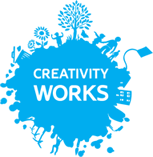Socially Engaged Art
Creativity Works believes that the success of the projects that we deliver depends upon the relationships that develop between artists, communities, community organisers and the organisations who deliver services within communities. The creative collaborations that result are socially engaged because they deliver locally specific and community led outcomes for and with communities. Socially engaged art is situated within the wider arena of Public Art and is defined by Miwon Kwon in, One Place After Another: Site Specificity and Locational Identity [MIT Press, 2002] as art- in-the-public-interest, as it foregrounds social issues, political activism and community collaborations.
Creativity Works has been refining its perspective on socially engaged art over recent years, talking with artists and arts organisations, exploring engagement through artists in residence projects and asking participants for their views on what works and how. We have also researched current thinking and practice in the socially engaged arts and believe that our work relates to the theories outlined here.
Definitions of Socially Engaged Art
According to Lynn Froggett, et al., in their report “New Model Visual Arts Organisations & Social Engagement”, socially engaged practices are developed and delivered:
“…through collaboration, participation, dialogue, provocation and immersive experiences. The organisations focus on process and seek to embed themselves within the communities among whom they work. This puts them in a position to respond to the specific needs and agendas of communities and hence to widen audience participation.”
In addition, Creativity Works aligns its methodology with New Genre Public Art as described by Suzanne Lacy [Ed], in Mapping the Terrain: New Genre Public Art, USA, Bay Press, 1995. Lacy states that New Genre Public Art work:
- Engages with culture
- Seeks a relationship with its audience
- Aims to influence social strategy.
The artists who work in this genre can be described as operating with an “expanded repertoire” which includes social issues, creative and learning processes as well as artistic production, and with the goal “to make art that matters”.
The artists “expanded repertoire”, makes possible a more intimate and engaged relationship for the artist with their audience, enables them to consider their intentions in a social as well as a cultural field, promotes interaction and questions effectiveness.
Our research has enabled us to formulate our own Creativity Works Perspective and we believe that:
Creativity Works because it:
- Engages with culture
- Seeks a relationship with its audience
- Aims to influence social strategy.
The artists “expanded repertoire”, makes possible:
- A more intimate and engaged relationship for the artist with their audience,
- enables them to consider their intentions in a social as well as a cultural field,
- promotes interaction and change
- questions effectiveness. [Lacy]
The expanded repertoire includes:
- Social change
- Personal development, wellbeing, informal learning, transferable skills development
- Community development and cohesion – stronger communities with a sense of pride and belonging and ownership
- Artistic production – ‘Making art that matters’ – [Lacy]
The focus of Creativity Works, our artists and participants reflects the above definitions of Socially Engaged Art and Socially Engaged Practice and seeks to deliver positive social change as a result.
Creativity Works ensures that our artists are socially engaged: meaning that they work with genuine depth and ‘an expanded repertoire’. As a result, participants feel supported and have time and space for personal and social reflection, development, and progression: they explore social issues, creative learning processes and artistic production. Artists interweave real quality in to creative processes and individual and group outcomes. In addition, the participants learn transferable skills: as well as the art form itself, they learn communications, reflection tools, how to research and develop an idea, group communications and interpersonal skills.
Our research and thinking has also helped us to define the skills that artists need to effectively deliver social outcomes and has resulted in the development of our Co|Create Programme a comprehensive support and development offer for socially engaged artists.
